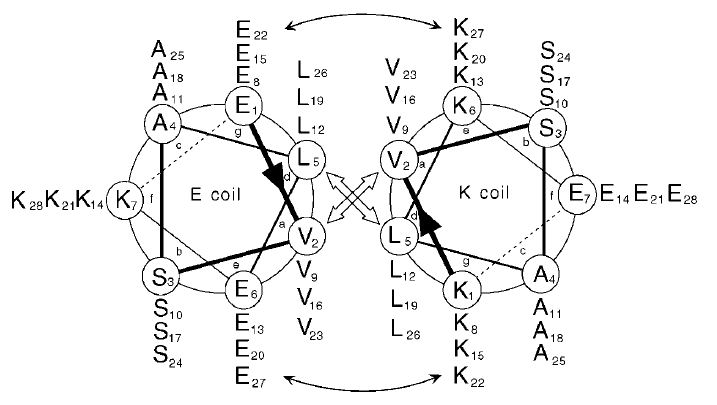Team:Wageningen UR/Coil system
From 2012.igem.org
PnAS
A big challenge of our project is the attachment of ligands and functional proteins on either the outside or inside of a virus-like particle (VLP). We decided to use a noncovalent anchor-like system, which consists of two different coiled-coil proteins. For various experiments the E-/K-coil combination IAAL E3 and IAAL K3 reported by Litowksi et al. in 2002 was used.
 fig. 1 homodimeric GCN4 leucine zipper
fig. 1 homodimeric GCN4 leucine zipper
α-helical coiled-coils represent an widely abundant but simple oligomerization motif in proteins. They have an enormous diversity of functions in nature ranging from motor proteins to transcription factors and chaperones [1]. Coiled-coils are comprised of one single secondary protein structure: the α-helix. Their quaternary structure is stable and does not unfold in aqueous solution at a neutral pH unlike other peptide α-helices. One of the striking structural features of the coiled coils is their build-up of two to five α-helices. These helices contain a heptad repeat of mainly apolar amino acids which is denoted as (abcdefg)n in literature. The letters a and d are usually amino acids with a highly hydrophobic side chain. The side chains are packed against each other forming a hydrophobic core which allows the formation of a supercoil. Whereas the letter n is representing the number of helices in the final coil. The helices can be identical or even different in sequence and may be aligned in a parallel/antiparallel way. The amino acids of the letters e and g have typically charged residues to allow electrostatic interactions with other peptides (most importantly other coils)[2]. The process of dimerization is largely dependent on the peptide sequence and can be homodimeric (fig 1.) or heterodimeric (e.g. E- and K-coil). In our project we are utilizing heterodimeric coiled-coils to noncovalently attach proteins. This system is advantageous because of the high stability and specificity. The use of heterodimeric coils additionally prevents the self-dimerization of either the virus capsid monomer or the protein ( or ligand) of choice.

In fig. 2 the chemical interactions of a E- and K-coil pair are shown, unfortunately not the pair we have used in the course of our experiments. The wide white arrows depict the interhelical hydrophobic interactions (hydrophobic core)[2]. The thin arrows display the electrostatic attractions of the two coils on each other. As mentioned before these electrostatic interactions are caused by the amino acids present on position e and g. In this case glutamic acid (E) and lysine (K). All these interactions greatly contribute to the stability and the prevention of self-dimerization.
The correct amino acid sequence of the coil pair IAAL E3 and IAAL K3, which we have implemented in our experiments is stated in table 1[2]. The choice of this pair was made to have a reasonably short coil with only 3 heptad repeats to avoid interference with the quaternary structure of the capsid proteins.
| name | peptide sequence |
| gabcdefgabcdefgabcdef | |
| IAAL E3 | Ac-EIAALEKEIAALEKEIAALEK-NH2 |
| IAAL K3 | Ac-KIAALKEKIAALKEKIAALKE -NH2 |
 "
"









